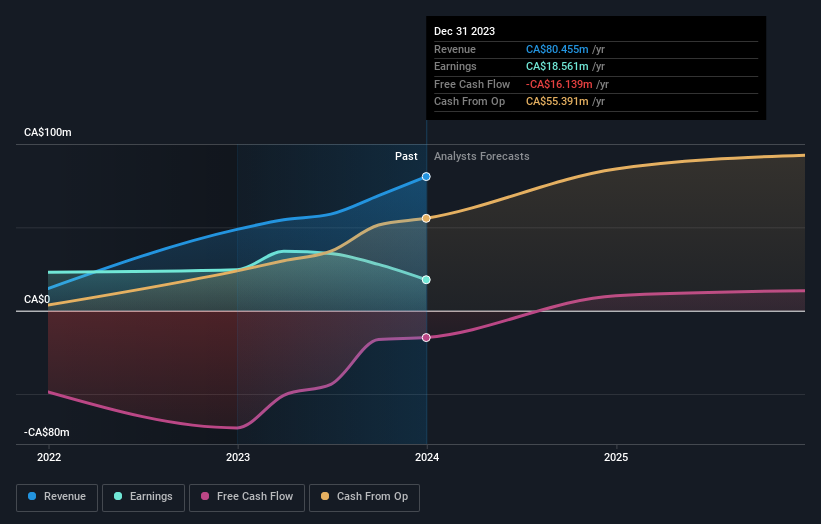While private companies own 29% of Rubellite Energy Inc. (TSE:RBY), individual investors are its largest shareholders with 58% ownership
Key Insights
The considerable ownership by individual investors in Rubellite Energy indicates that they collectively have a greater say in management and business strategy
The top 16 shareholders own 42% of the company
Using data from company's past performance alongside ownership research, one can better assess the future performance of a company
A look at the shareholders of Rubellite Energy Inc. (TSE:RBY) can tell us which group is most powerful. We can see that individual investors own the lion's share in the company with 58% ownership. Put another way, the group faces the maximum upside potential (or downside risk).
Private companies, on the other hand, account for 29% of the company's stockholders.
In the chart below, we zoom in on the different ownership groups of Rubellite Energy.
See our latest analysis for Rubellite Energy
What Does The Institutional Ownership Tell Us About Rubellite Energy?
Institutions typically measure themselves against a benchmark when reporting to their own investors, so they often become more enthusiastic about a stock once it's included in a major index. We would expect most companies to have some institutions on the register, especially if they are growing.
Since institutions own only a small portion of Rubellite Energy, many may not have spent much time considering the stock. But it's clear that some have; and they liked it enough to buy in. If the business gets stronger from here, we could see a situation where more institutions are keen to buy. It is not uncommon to see a big share price rise if multiple institutional investors are trying to buy into a stock at the same time. So check out the historic earnings trajectory, below, but keep in mind it's the future that counts most.
Rubellite Energy is not owned by hedge funds. Treherne Resources Ltd. is currently the largest shareholder, with 29% of shares outstanding. In comparison, the second and third largest shareholders hold about 5.8% and 3.1% of the stock. Susan L. Rose, who is the second-largest shareholder, also happens to hold the title of Chief Executive Officer.
A deeper look at our ownership data shows that the top 16 shareholders collectively hold less than half of the register, suggesting a large group of small holders where no single shareholder has a majority.
While it makes sense to study institutional ownership data for a company, it also makes sense to study analyst sentiments to know which way the wind is blowing. There is a little analyst coverage of the stock, but not much. So there is room for it to gain more coverage.
Insider Ownership Of Rubellite Energy
While the precise definition of an insider can be subjective, almost everyone considers board members to be insiders. The company management answer to the board and the latter should represent the interests of shareholders. Notably, sometimes top-level managers are on the board themselves.
Insider ownership is positive when it signals leadership are thinking like the true owners of the company. However, high insider ownership can also give immense power to a small group within the company. This can be negative in some circumstances.
We can see that insiders own shares in Rubellite Energy Inc.. As individuals, the insiders collectively own CA$14m worth of the CA$159m company. This shows at least some alignment, but we usually like to see larger insider holdings. You can click here to see if those insiders have been buying or selling.
General Public Ownership
The general public, mostly comprising of individual investors, collectively holds 58% of Rubellite Energy shares. This level of ownership gives investors from the wider public some power to sway key policy decisions such as board composition, executive compensation, and the dividend payout ratio.
Private Company Ownership
Our data indicates that Private Companies hold 29%, of the company's shares. It might be worth looking deeper into this. If related parties, such as insiders, have an interest in one of these private companies, that should be disclosed in the annual report. Private companies may also have a strategic interest in the company.
Next Steps:
It's always worth thinking about the different groups who own shares in a company. But to understand Rubellite Energy better, we need to consider many other factors. For example, we've discovered 1 warning sign for Rubellite Energy that you should be aware of before investing here.
If you would prefer discover what analysts are predicting in terms of future growth, do not miss this free report on analyst forecasts.
NB: Figures in this article are calculated using data from the last twelve months, which refer to the 12-month period ending on the last date of the month the financial statement is dated. This may not be consistent with full year annual report figures.
Have feedback on this article? Concerned about the content? Get in touch with us directly. Alternatively, email editorial-team (at) simplywallst.com.
This article by Simply Wall St is general in nature. We provide commentary based on historical data and analyst forecasts only using an unbiased methodology and our articles are not intended to be financial advice. It does not constitute a recommendation to buy or sell any stock, and does not take account of your objectives, or your financial situation. We aim to bring you long-term focused analysis driven by fundamental data. Note that our analysis may not factor in the latest price-sensitive company announcements or qualitative material. Simply Wall St has no position in any stocks mentioned.


